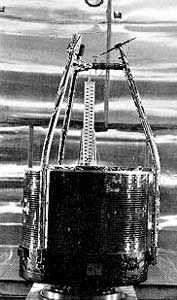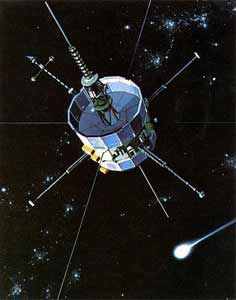
Home - Search - Browse - Alphabetic Index: 0- 1- 2- 3- 4- 5- 6- 7- 8- 9
A- B- C- D- E- F- G- H- I- J- K- L- M- N- O- P- Q- R- S- T- U- V- W- X- Y- Z
ISEE
 ICE Credit: NASA |
AKA: International Sun-Earth Explorer. Status: Operational 1977. First Launch: 1977-10-22. Last Launch: 1978-08-12. Number: 3 .
The purposes of the mission were: (1) to investigate solar-terrestrial relationships at the outermost boundaries of the Earth's magnetosphere; (2) to examine in detail the structure of the solar wind near the Earth and the shock wave that forms the interface between the solar wind and Earth's magnetosphere; (3) to investigate motions of and mechanisms operating in the plasma sheets; and, (4) to continue the investigation of cosmic rays and solar flare emissions in the interplanetary region near 1 AU. The three spacecraft carried a number of complementary instruments for making measurements of plasmas, energetic particles, waves, and fields.
The mission thus extended the investigations of previous IMP spacecraft. The launch of three coordinated spacecraft in this mission permitted the separation of spatial and temporal effects. This heliocentric spacecraft had a spin axis normal to the ecliptic plane and a spin rate of about 20 rpm. It was initially placed into an elliptical halo orbit about the Lagrangian libration point (L1) 235 Earth radii on the sunward side of the Earth, where it continuously monitored changes in the near-Earth interplanetary medium. In conjunction with the mother and daughter spacecraft, which had eccentric geocentric orbits, this mission explored the coupling and energy transfer processes between the incident solar wind and the Earth's magnetosphere. In addition, the heliocentric ISEE 3 spacecraft also provided a near-Earth baseline for making cosmic-ray and other planetary measurements for comparison with corresponding measurements from deep-space probes. ISEE 3 was the first spacecraft to use the halo orbit. In 1982 ISEE 3 conducted a series of maneuvers that resulted in it being ejected out of the Earth-Moon system and into a heliocentric orbit ahead of the Earth, on a trajectory intercepting that of Comet Giacobini-Zinner. At this time, the spacecraft was renamed International Cometary Explorer (ICE). The primary scientific objective of ICE was to study the interaction between the solar wind and a cometary atmosphere. The spacecraft traversed the plasma tail of Comet Giacobini-Zinner and made in situ measurements of particles, fields, and waves. It also transited between the Sun and Comet Halley, when other spacecraft (Giotto, Planet-A, MS-T5, VEGA) were also in the vicinity of Comet Halley on their comet rendezvous missions. ICE became the first spacecraft to directly investigate two comets. Tracking and telemetry support have been provided by the DSN (Deep Space Network). The ISEE bit rate was nominally 2048 bps during the early part of the mission, and 1024 bps during the Giacobini-Zinner comet encounter. An update to the ICE mission was approved by NASA headquarters in 1991. It defined a Heliospheric mission for ICE consisting of investigations of coronal mass ejections in coordination with ground-based observations, continued cosmic ray studies, and special period observations such as when ICE and Ulysses were on the same solar radial line. Termination of operations of ISEE 3 was authorized May 5, 1997.
More at: ISEE.
| ISEE 2 Research satellite built by Dornier-System GmbH for ESA, Europe. Launched 1977. |
| ISEE 3 Research, Comet fly-by satellite built by Fairchild for NASA / ESA, USA. Launched 1978. |
Family: Earth, High earth orbit, Magnetosphere sat. Country: USA. Launch Vehicles: Thor, Delta, Delta 2914, Delta 2000. Launch Sites: Cape Canaveral, Cape Canaveral LC17B. Agency: NASA. Bibliography: 2, 296, 6, 6601, 12689.
 | ISEE 1 Credit: Manufacturer Image |
 | ISEE 2 Credit: Manufacturer Image |
 | ISEE 3 → ICE Credit: Manufacturer Image |
1977 October 22 - . 13:53 GMT - . Launch Site: Cape Canaveral. Launch Complex: Cape Canaveral LC17B. LV Family: Thor. Launch Vehicle: Delta 2914.
- ISEE 1 - . Payload: ISEE A. Mass: 340 kg (740 lb). Nation: USA. Agency: NASA Greenbelt. Class: Earth. Type: Magnetosphere satellite. Spacecraft: ISEE. Decay Date: 1987-09-26 . USAF Sat Cat: 10422 . COSPAR: 1977-102A. Apogee: 137,806 km (85,628 mi). Perigee: 436 km (270 mi). Inclination: 12.70 deg. Period: 3,441.00 min. International Sun-Earth Explorer. Spacecraft engaged in research and exploration of the upper atmosphere or outer space (US Cat B). .
- ISEE 2 - . Payload: ISEE B. Mass: 166 kg (365 lb). Nation: Europe. Agency: ESA. Class: Earth. Type: Magnetosphere satellite. Spacecraft: ISEE. Decay Date: 1987-09-26 . USAF Sat Cat: 10423 . COSPAR: 1977-102B. Apogee: 137,765 km (85,603 mi). Perigee: 406 km (252 mi). Inclination: 13.50 deg. Period: 3,438.50 min. International Sun-Earth Explorer. .
1978 August 12 - . 15:12 GMT - . Launch Site: Cape Canaveral. Launch Complex: Cape Canaveral LC17B. LV Family: Thor. Launch Vehicle: Delta 2914.
- ISEE 3 - .
Payload: ISEE C. Mass: 479 kg (1,056 lb). Nation: USA.
Agency: NASA Greenbelt.
Class: Earth.
Type: Magnetosphere satellite. Spacecraft: ISEE.
USAF Sat Cat: 11004 . COSPAR: 1978-079A. Apogee: 1,089,200 km (676,700 mi). Perigee: 181 km (112 mi). Inclination: 1.00 deg. Period: 67,852.90 min.
International Sun-Earth Explorer; later renamed the International Cometary Explorer. Measured interaction between solar wind and Earth; rendezvoused with comet Giacobini-Zinner September 11, 1985. After several passes through the Earth's magnetotail, with gravity assists from lunar flybys in March, April, September and October of 1983, a final close lunar flyby (119.4 km above the moon's surface) on December 22, 1983, ejected the spacecraft out of the Earth-Moon system and into a heliocentric orbit ahead of the Earth, on a trajectory intercepting that of Comet Giacobini-Zinner. A total of fifteen propulsive maneuvers (four of which were planned) and five lunar flybys were needed to carry out the transfer from the halo orbit to an escape trajectory from the earth-moon system into a heliocentric orbit. The primary scientific objective of ICE was to study the interaction between the solar wind and a cometary atmosphere. As planned, the spacecraft traversed the plasma tail of Comet Giacobini-Zinner on September 11, 1985, and made in situ measurements of particles, fields, and waves. It also transited between the Sun and Comet Halley in late March 1986, when other spacecraft (Giotto, Planet-A, MS-T5, VEGA) were also in the vicinity of Comet Halley on their comet rendezvous missions. ICE became the first spacecraft to directly investigate two comets. An update to the ICE mission was approved by NASA headquarters in 1991. It defined a Heliospheric mission for ICE consisting of investigations of coronal mass ejections in coordination with ground-based observations, continued cosmic ray studies, and special period observations such as when ICE and Ulysses are on the same solar radial line. As of January 1990, ICE was in a 355 day heliocentric orbit with an aphelion of 1.03 AU, a perihelion of 0.93 AU and an inclination of 0.1 degree. This will bring it back to the vicinity of the earth-moon system in August, 2014. Termination of operations of ISEE 3 was authorized May 5, 1997.
International Sun-Earth Explorer 3 spacecraft, also known as the International Cometary Explorer after its trip to P/Giacobini-Zinner in 1985, returned to the vicinity of the Earth in August 2014 following 30 years in solar orbit. On April 18 ISEE 3 was in a 0.927 x 1.034 AU x 0.06 deg solar orbit at a distance of 28.9 million km from Earth. A group of enthusiasts attempted to revive the spacecraft. ISEE 3 was the first spacecraft at the Earth-Sun L1 Lagrange point. However, in a special 1986 ceremony NASA Administrator James Fletcher transferred ownership of the spacecraft from NASA to the Smithsonian Institution. Additional Details: here....
1985 September 11 - .
1986 March 28 - .
1997 May 5 - .
Back to top of page
Home - Search - Browse - Alphabetic Index: 0- 1- 2- 3- 4- 5- 6- 7- 8- 9
A- B- C- D- E- F- G- H- I- J- K- L- M- N- O- P- Q- R- S- T- U- V- W- X- Y- Z
© 1997-2019 Mark Wade - Contact
© / Conditions for Use